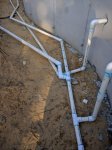a) 2" pipes, b) head loss around bends
our pb indicated that he uses 2" pipes. now that the pipes are actually installed, i noticed that the output from the pump is a single 2" pipe that connects to a "T" of two 1.5" pipes. those 1.5" pipes feed 3 returns, 1 return from the left side of the "T" and two returns from the right side of the "T". The first of those two returns on the right side is 1 foot from the "T" whereas the other is roughly 20' from the "T" which is roughly equidistant to the other return on the left side of the T. will the downstepping in pipe diameter help or hurt head loss? are "T"s usually used and if so how do they impact headloss versus other ways of accomplishing the same goal?
secondly, our pb when he showed his demo pump pad, showed 2" pipes with sweep elbows. yet nearly every pipe in the ground is either a 45* angle or a hard 90* angle elbow with no sweeping to it. /\ or |_. do people usually use sweeping elbows in ground? it seems odd that they go through all that trouble to plump the equipment with sweep elbows but then move most of the water to the pool with hard angle elbows? am i wrong here?
what should i expect? meaning what's ideal?
it's a mountain lake shaped pool. 25k gallons.
- - - Updated - - -
given this configuration:
Analysis of Plumbing Loops and Other Configurations
it looks like semi binary loop with return #2 omitted.
- - - Updated - - -
the difference being that everything after the initial T, leading up to the returns, is 1.5". that link seems to indicate the dowstepping happens only for 2' on the 1.5" return. the pvc off of which all returns stem is 1.5, which is fed by a T of 2".
|_______|_______| <----all 1.5"
P_____| <----all 2"
P is pump
- - - Updated - - -
as an aside, assuming they skimped on the underground elbows, and possibly even semi binary pipe sizing, i guess attempting to run a semi binary configuration is a plus, right? they were willing to pay for extra pipe in an attempt to get equal return pressure?
our pb indicated that he uses 2" pipes. now that the pipes are actually installed, i noticed that the output from the pump is a single 2" pipe that connects to a "T" of two 1.5" pipes. those 1.5" pipes feed 3 returns, 1 return from the left side of the "T" and two returns from the right side of the "T". The first of those two returns on the right side is 1 foot from the "T" whereas the other is roughly 20' from the "T" which is roughly equidistant to the other return on the left side of the T. will the downstepping in pipe diameter help or hurt head loss? are "T"s usually used and if so how do they impact headloss versus other ways of accomplishing the same goal?
secondly, our pb when he showed his demo pump pad, showed 2" pipes with sweep elbows. yet nearly every pipe in the ground is either a 45* angle or a hard 90* angle elbow with no sweeping to it. /\ or |_. do people usually use sweeping elbows in ground? it seems odd that they go through all that trouble to plump the equipment with sweep elbows but then move most of the water to the pool with hard angle elbows? am i wrong here?
what should i expect? meaning what's ideal?
it's a mountain lake shaped pool. 25k gallons.
- - - Updated - - -
given this configuration:
Analysis of Plumbing Loops and Other Configurations
it looks like semi binary loop with return #2 omitted.
- - - Updated - - -
the difference being that everything after the initial T, leading up to the returns, is 1.5". that link seems to indicate the dowstepping happens only for 2' on the 1.5" return. the pvc off of which all returns stem is 1.5, which is fed by a T of 2".
|_______|_______| <----all 1.5"
P_____| <----all 2"
P is pump
- - - Updated - - -
as an aside, assuming they skimped on the underground elbows, and possibly even semi binary pipe sizing, i guess attempting to run a semi binary configuration is a plus, right? they were willing to pay for extra pipe in an attempt to get equal return pressure?


